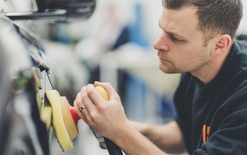VW scandal: tech specs
Posted on 05 October, 2015
Regulators in the US have alleged that Volkswagen installed software into its cars that allowed the autos to circumvent Environment Protection Agency (EPA) tests there.
To understand more about how VW cheated, the EPA’s testing process needs explaining, reports www.washingtonpost.com. When carmakers test their vehicles against EPA standards, they place a car on rollers and then perform a series of specific moves as prescribed by federal regulations.
Among the most common tests for passenger cars is the urban dynamometer driving schedule, which simulates 7.5 miles of urban driving. In the first 505 seconds of the test, the driver pushes the car to highway-level speeds. The second phase of the test looks more like stop-and-go city traffic conditions. In all these tests, the driver has to stay within two miles per hour of the required speed at any given moment. Along the way, testers collect emissions data.
There’s a test to simulate aggressive driving, which tops 88mph, and a test that mimics urban driving on a hot summer day with the air conditioning on full blast. In the end, detailed requirements for each test gave VW advance knowledge it needed to teach its cars when to behave more cleanly.
By measuring how long the engine was running, the vehicle’s speeds, and even seemingly esoteric factors, such as the position of the steering wheel and barometric pressure, VWs could “understand” they were being tested and so adjusted their engine performance to pass the tests, according to the EPA.
At all other times, the EPA says, such as when consumers were actually driving the cars, VW would use a different “road calibration” that increased emissions of nitrogen oxide, a component in urban smog, up to 40 times federal standards.
Using a special engine setting for vehicle tests isn’t all that unusual, according to Consumer Reports. Most new vehicles do something similar because otherwise they might interpret some of the testing procedures, such as traction issues from being on rollers, as dangerous.
But the problem here is the EPA says VW used its testing mode in an inappropriate attempt to beat the system. Designing a piece of software aimed at tricking the EPA isn’t really the hard part, according to Arvind Thiruvengadam, a professor at West Virginia’s Centre for Alternative Fuels, Engines and Emissions, which helped run independent tests on VW’s diesel cars. “Knowing when to switch to the EPA-favourable cycle is the trick,” he says.
So if VW is capable of setting its cars to run cleanly, then why doesn’t it do so all the time? The answer is that there’s a trade-off between cleanliness and performance. If the car ran on the “clean” map all the time, it would be apparent that the driving experience and customer value – fuel economy and power – would be significantly impacted.
MORE OF THE TECHNICAL STUFF
Ever since news broke that VW had cheated on its emission controls, there have been nagging questions about how it got away with it, and why it took an independent research team to find the errors in the first place, reports
www.extremetech.com.
VW was able to hide its fraudulent settings by programming its vehicles to detect when they entered what’s known as “test mode”. All modern cars have test modes they can engage for fuel-efficiency testing because this and emissions are typically tested on a rolling device called a dynamometer.
This allows the EPA or any other organisation to monitor every car in the same way, and ensures an equivalent test environment across devices. Modern cars, however, don’t like having just their front wheels rolling while the back wheels are stationary, and will interpret this as a traction or stability-control problem.
In order to prevent the car from sabotaging its own test, the vehicle is placed in this test mode, which is part of the entire process and nothing sinister.
In VW’s case, setting the car to test mode is what explicitly told the vehicle to use its full emissions control technology. Set the car to normal mode, and it went on spewing out particulates and nitrous oxide, both of which contribute heavily to smog.
VW’s downfall came at the hands of a small West Virginia University team working for the Centre for Alternative Fuels, Engines and Emissions (CAFEE). It was contacted by the International Council on Clean Transportation (ICCT) to conduct real-world tests on light-duty diesel vehicles.
The ICCT had observed that European vehicles were generally emitting four to seven times more pollution than was permitted by EU standards, but knew American vehicles were meeting much stricter test conditions established by California.
The point of the study was to gather data about US vehicles under US conditions. Testing vehicles under these kinds of conditions is anything but easy and these vehicles weren’t just driven in a circle or across an arbitrary route. The researchers logged thousands of kilometres of test driving in monitored conditions, and in ways designed to ensure appropriate metrics were being gathered.
VW results when their vehicles were tested in the FTP-75 ‘Bag 3’ chassis dyno test were also noted. This is the “test mode” scenario described above. When the vehicles knew they were undergoing emission testing, they were fully capable of conforming to the strictest Tier2 Bin5 standard.
This ocean of data was later turned over to authorities, which used it to begin questioning VW for answers. After stonewalling for more than a year, VW eventually came clean and acknowledged it had been cheating all along.
Half of its sales in Europe, the marque’s biggest market, are for diesel cars. Its shares plunged by about 30 per cent in the first few days after the scandal broke with other carmakers also seeing big falls in their stock prices.
In 2014, US regulators raised concerns about VW’s emissions levels, but these were dismissed by the company as “technical issues” and due to “unexpected” real-world conditions.
California’s Air Resources Board is now looking into other marques’ testing results. Ford, BMW, and Renault-Nissan say they don’t use defeat devices, while other firms have yet to respond or say they have complied with laws.
The European Union operates a different system to the US with all tests there performed in strict conditions as required by EU law and witnessed by a government-appointed independent approval agency.
However, the industry there acknowledges current testing methods are outdated, and is seeking agreement from the European Commission for a regime that embraces new testing technologies and better represents on-road conditions.
Over the past decade and more, carmakers have invested heavily into the production of diesel vehicles – with the support of many governments – believing they are better for the environment.
Latest scientific evidence suggests that may not be the case and there are even moves to limit diesel cars in some cities, while the VW scandal is are likely to lead to a fall in demand for diesel engine cars.





